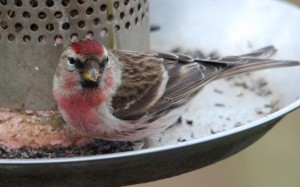 The last three weeks have been exciting for people who feed and watch birds in the garden. Following on from these Country Notes a few weeks ago, there has been a very welcome influx of lesser redpolls into gardens. They are particularly fond of nyjer seed which are very small, and makes them, for their small beaks, easy to handle. A number of readers have commented on this influx with some asking for identification and others wanting to know more about them. Whether people have been looking more closely after the article or whether there has been an actual influx is difficult to say. I suspect that there has been an influx and may be due to the fact that the usual natural food from such sources as birch seed is scarce this spring or non-existent. However, there is another theory to explain this sudden and welcome influx. For the last few years, way down south, redpolls have been very frequent visitors to bird feeders and perhaps this habit has at last spread to the Highlands.
The last three weeks have been exciting for people who feed and watch birds in the garden. Following on from these Country Notes a few weeks ago, there has been a very welcome influx of lesser redpolls into gardens. They are particularly fond of nyjer seed which are very small, and makes them, for their small beaks, easy to handle. A number of readers have commented on this influx with some asking for identification and others wanting to know more about them. Whether people have been looking more closely after the article or whether there has been an actual influx is difficult to say. I suspect that there has been an influx and may be due to the fact that the usual natural food from such sources as birch seed is scarce this spring or non-existent. However, there is another theory to explain this sudden and welcome influx. For the last few years, way down south, redpolls have been very frequent visitors to bird feeders and perhaps this habit has at last spread to the Highlands.
One or two readers have been lucky enough to see a male redpoll as at this time of the year the pink breast is very attractive. The extent of this pink feathering seems to vary between individuals but it is very conspicuous. I took the photograph of a typical male in my garden last week and the bird is at the base of a feeder filled with nyjer. At the same time there was a female redpoll, two siskins and a goldfinch on the same feeder. The recent cold weather has been reflected in the number of birds coming to feeders and once again readers have commented on this. The birds seem to know what the weather will be over the ensuing night and day and if they are going to be cold then late afternoon the feeders are packed with birds. The nyjer and sunflower hearts attracts the siskins, more than I can ever remember before, plus the redpolls, occasional greenfinches and a few chaffinches. Most of the siskins have been males because the females are now on eggs. The blue, great and to a lesser extent coal tits seem to be few and far between. Why this scarcity of these three small birds is a mystery although again it could be tied in with lack of natural food around.
Interestingly the amount of colour on the redpolls varies with individuals. Some of the males may not have any pink on the breast and they can easily be mistaken for females. Even the red cap, or poll, varies and can not only be red but also yellow, gold or even brown. The birds are only slightly smaller than the siskin but even when they are side by side on a feeders this difference in size is scarcely noticeable. Redpolls will nest in large gardens and they are loose colonial birds which means five or six pairs may nest in close proximity. Once the first breeding attempt has ended the bird may well have a second brood but this depends on the availability of food. At the end of the breeding season the birds gather together in flocks in which they will stay for the winter until next spring. A few years ago redpoll numbers were in decline but there is some evidence that this decline in numbers may have halted.
By far the best book on garden birds is “Garden Birds & Wildlife” by Mike Toms and Paul Sterry. I prefer the hardback version published by the AA in 2011.
